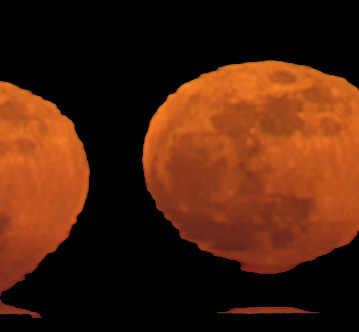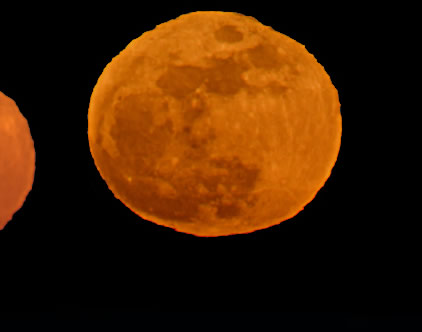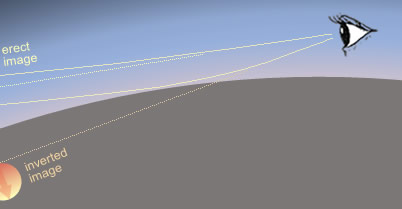Maine Miraged Moonrise Imaged by John Stetson at Casco Bay, Cape Elizabeth, Maine on February 9, 2009. ©John Stetson, shown with permission.
A full moon, reddened as the atmosphere preferentially scatters away blue light, rises slowly over the ocean. The first recognisable feature is Mare Crisium but as the moon climbs it distorts, separates into two and the lower moon slides back into the ocean. A rare classical 'Etruscan Vase' or 'Omega' mirage of the moon - more usually seen happening to the setting sun.
The mirage was produced by warm air at the ocean surface with cooler air above and the resulting air temperature gradient changing rapidly with height. Here the water was a relatively warm 39 F while the air well above it a cold 18 F. Rays from the moon were refracted back upwards as they passed between the cool and warm layers. Refraction always tends to deflect rays towards the denser (colder) layer. If you are above the warmer layer you see two lunar images or parts of them (1) an erect image from rays that pass relatively undeflected above the warm layer and (2) a lower inverted image from rays mirrored upwards by the warm layer. Each moon image is as 'real' as the other. The effect is not dissimilar to the mirage seen above a hot road surface.
This is the stuff of the Jules Verne 'inferior mirage' type green flash. The image region from rays passing through the strong temperature gradient at the warm-cold air boundary is vertically magnified accentuating the normally invisible green rim at the moon's or sun's upper limb into a brilliant green flash. The flash is visible at sunrise or moonrise but is more easily seen during the setting with the benefit of knowing exactly when and where to catch it.
The mirage and possible flash depend on your height above the sea surface. You must be above the warm air layer but climb too high and the effects diminish.
|












